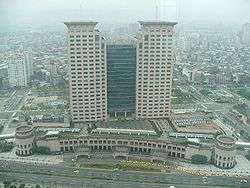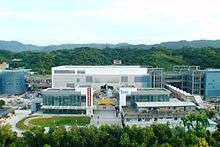Taipei Railway Underground Project

The Taipei Railway Underground Project is an ongoing project in Taipei, Taiwan to remove surface railway facilities, replacing them with a 22.5 kilometres (14.0 mi) tunnel[1] and new facilities outside the city limits. The underground section includes separate tunnels for the 3 ft 6 in (1,067 mm) tracks of national rail carrier Taiwan Railway Administration's (TRA) Western Line and for the Standard gauge tracks of Taiwan High Speed Rail Corporation (THSRC). All stations on the section are rebuilt as multi-level complexes, which also function as transport hubs, with underground platforms for TRA and THSRC trains, and new stations of the Taipei Metro at deeper levels.
First phase
In the early 1980s, railway facilities in central Taipei were seen as obstacles to rail traffic and local development, and were seen as bad for the city's appearance.[2] Therefore, the executive branch of Taiwan's government, the Executive Yuan, tasked the Taipei Railway Underground Project Organisation (TRUPO)[3] with the project to rebuild railway facilities.[2]
The first phase of the project was the complete reconstruction of Taipei Main Station as a multi-level building, with train platforms placed underground along with adjacent tracks.[2] Work on the 4.42 km (2.75 mi) section between Huashan and Wanhua began in July 1983, and was completed after NT$17.792 billion spent in September 1989.[2]
Second phase
In the nineties, the tunnel was extended both eastward and westward, and with separate double track north and south tunnels, preparation was made for Taiwan High Speed Rail, the planned high-speed line to Kaohsiung. The eastward extension, the Songshan Project, added 5.33 km (3.31 mi) to Songshan.[4] The project cost NT$27.48 billion, and was in construction from July 1989 until June 1994.[4] On the surface, the space gained was used for the construction of the elevated Civic Blvd Expressway, which opened in September 1997.[4]

The westward extension, the Wanhua–Banqiao Project, added 7.18 km (4.46 mi) to the four-track tunnel section, on a new alignment with the newly built Wanhua Station and the rebuilt Banqiao Station along it.[5] The total project length was 15.38 km (9.56 mi), which included the upgrade of TRA's surface tracks, and a new Shulin Coach Yard at the end of the upgraded section, built to maintain TRA's electric multiple unit (EMU) and diesel multiple unit (DMU) fleet.[5] Work started in September 1992, and TRA began to use the underground tracks in the north tunnel in July 1999.[5]
The extensions also include emergency stations, where passengers can be evacuated in case of fire. The stations and emergency stations were fitted with a smoke suppression system that was tested with simulations and a live evacuation trial in Wanhua Station.[1]
The first 14 km (8.7 mi)[6] of the south tunnel and its exit forms an altogether 15.8 km (9.8 mi) section of the THSR.[7] Civil works were the responsibility of TRUPO.[3]
When work started on the south tunnel, TRA's management was concerned that TRA's capacity would be limited during construction.[7] TRA was to give up the tracks and some station platforms without receiving a compensation or rent.[8] Rail unions said that this arrangement would result in a reduction of TRA services by more than a fourth, and a loss of income and jobs, and organised a protest rally in March 2002, after which the Ministry of Transport agreed to re-negotiate the TRA–THSRC contract.[8] The cancellation of some TRA train services resulting from the final station platform lease agreement led to another union protest and threat of strike action in February 2003.[9] Unions continued to protest the TRA–THSRC agreement, accusing the government of having favoured THSRC.[10] Civil works in the south tunnel were completed in April 2003.[5]
After the completion of track construction, the western end of the south tunnel went into service on January 5, 2007, when THSRC's high-speed trains began to run between Taipei and Kaohsiung with Banqiao as the Taipei terminus.[11] The service was extended to Taipei Main Station on March 2, 2007.[12] The end of the completed 4.9 km (3.0 mi) track section east of Taipei was put into use as the Songshan Temporary Facility, for servicing the trains.[13]
Third phase

The NT$83.069 billion Nangang Project completes the Taipei Railway Underground Project with a 5.4 km (3.4 mi) eastward extension of the tunnel, including the rebuilt Songshan and Nangang Stations.[14] East of Nangang along TRA's Western Line, the project also includes a short mountain tunnel and a 5 km (3.1 mi) elevated section.[14] Wudu Freight Yard, near Wudu Station, and Qidu Marshalling Yard, next to Qidu Station, replaces facilities dissolved at Songshan Station.[14] The entire length of the TRA part of the Nangang Project is 19.585 km (12.170 mi) between Songshan and Qidu, and was to be completed in August 2011.[14] Construction was officially completed on October 23, 2011 and began service the following day on October 24, 2011.[15] As a separate NT$10 billion project, in March 2009, TRA also began building a new depot at Fugang, Taoyuan County (now Taoyuan City), to replace its Songshan Depot, which was reached crossing THSRC's tracks.[16]
Approaching Nangang Station from the west, THSRC's south tunnel swings above TRA's north tunnel, to connect to different levels of Nangang Station.[14] East of Nangang Station, THSR tracks swing to the right,[14] towards THSRC's planned Xizhi Depot.[13] The THSR level of Nangang Station is under construction for an October 2012 opening.[17]
With the railroad moved underground in the Songshan-Nangang area, a new 4.7 km (2.9 mi) road was created aboveground running from Keelung Road to Nangang Station.[18] An online ballot was created to let citizens vote on the name of the new road, scheduled to open in October 2011.
References
- 1 2 Yang, K.H.; Yeh, T.C. (2004). "Experimental Validation of the Taipei Underground Railway System under Emergency Operation Modes" (PDF). International Rail Safety Conference. Retrieved 2011-02-23.
- 1 2 3 4 "Taipei Main Station Project". Railway Reconstruction Bureau, Ministry of Transportation and Communications. Retrieved 2011-02-23.
- 1 2 Saleem, Amair (May 2006). "Taiwan's High Speed Rail: Technical Challenges". PB Network. Parsons Brinckerhoff. XXI (63). Retrieved 2010-10-06.
- 1 2 3 "Songshan Project". Railway Reconstruction Bureau, Ministry of Transportation and Communications. Retrieved 2011-02-23.
- 1 2 3 4 "Wanhua-Banqiao Project". Railway Reconstruction Bureau, Ministry of Transportation and Communications. Retrieved 2011-02-23.
- ↑ "Taiwan High-Speed Line On Course To Open In 2005 - High Speed: Far East". International Railway Journal. October 2002. Retrieved 2010-10-09.
- 1 2 "THSRC starts major work this month". Railway Gazette International. 2001-03-01. Retrieved 2010-10-09.
- 1 2 "Rail workers get their way". Taipei Times. 2002-03-27. Retrieved 2011-02-02.
- ↑ "Railway union plans big strike". Taipei Times. 2003-02-26. Retrieved 2011-02-02.
- ↑ "Railway workers plan protest". Taipei Times. 2003-06-13. Retrieved 2011-02-02.
- ↑ "High speed rail commences operations". Taipei Times. 2007-01-06. Retrieved 2010-09-28.
- ↑ "Taiwan Quick Take/Taipei HSR station opens". Taipei Times. 2007-03-02. Retrieved 2010-09-28.
- 1 2 Shima, Takashi (August 2007). "Taiwan High Speed Rail". Japan Railway & Transport Review (48): 40–46. Archived from the original (PDF) on 2011-01-13. Retrieved 2011-01-13.
- 1 2 3 4 5 6 "Nangang Project". Railway Reconstruction Bureau, Ministry of Transportation and Communications. Retrieved 2011-02-23.
- ↑ "市民大道南港段 24日通車". 中央通訊社. 2011-10-23. Retrieved 2011-10-23.
- ↑ "TRA holds groundbreaking ceremony for new depot". Taipei Times. 2009-04-01. Retrieved 2011-02-26.
- ↑ "Four stations to be added to Taiwan high speed rail". Focus Taiwan (CNA). 2010-04-26. Retrieved 2010-10-06.
- ↑ "Road-naming ballot in Taipei to run through Aug. 8". Focus Taiwan News Channel. 2011-07-25. Retrieved 2011-07-25.